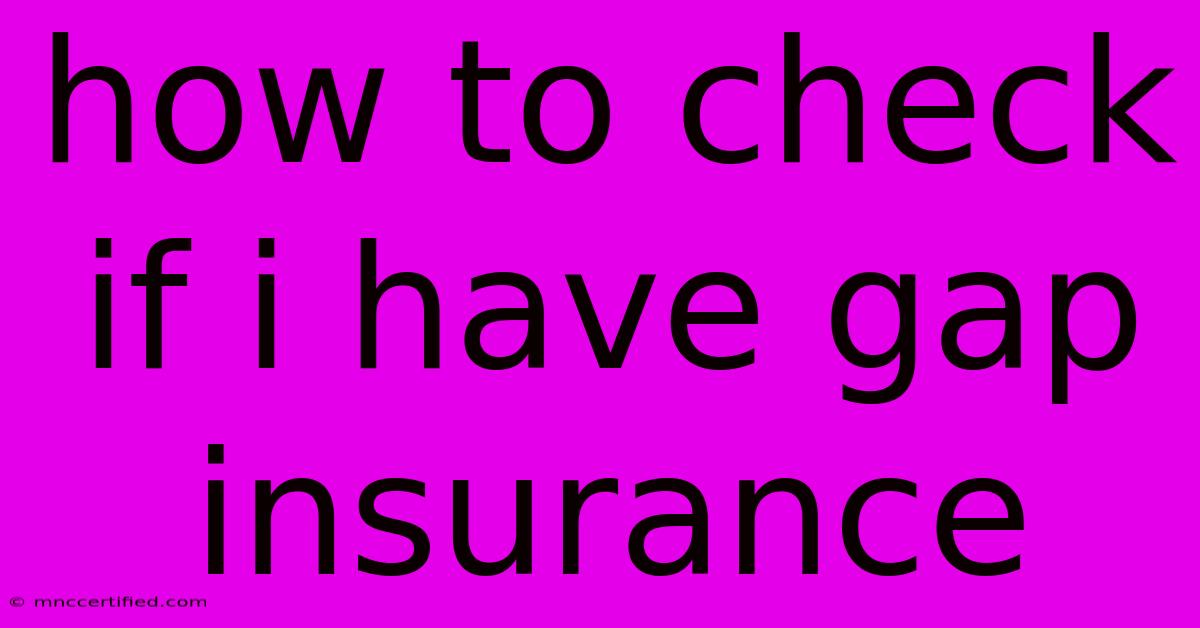How To Check If I Have Gap Insurance

Table of Contents
How to Check If You Have Gap Insurance: A Comprehensive Guide
Gap insurance is a crucial component of protecting yourself financially in the event of a car accident. It bridges the gap between the actual value of your vehicle and the amount your car insurance pays out after a total loss. Knowing whether you have this protection is essential for making informed financial decisions.
What is Gap Insurance?
Gap insurance is a supplementary insurance policy that covers the difference between your car's actual cash value (ACV) and the outstanding loan balance or lease payments. This is especially important when you finance or lease a car, as the ACV typically decreases over time due to depreciation.
Reasons to Check If You Have Gap Insurance
There are several reasons why knowing if you have gap insurance is crucial:
- Avoid a financial burden: If you're in an accident and your car is totaled, gap insurance ensures you don't end up owing more money than your car is worth.
- Peace of mind: Having gap insurance offers peace of mind knowing that you're financially protected in the event of a total loss.
- Prevent financial hardship: Without gap insurance, you could be left with a substantial loan balance or lease payments, putting a significant strain on your finances.
How to Check for Gap Insurance
Here are several ways to verify if you have gap insurance:
1. Review Your Insurance Policy Documents
- Check your policy booklet: Look for sections related to additional coverage or supplemental insurance.
- Review your policy online: Many insurance companies provide access to policy documents online through your account portal.
- Contact your insurance agent: Reach out to your agent or broker directly for clarification.
2. Contact Your Lender or Leasing Company
- Review your loan or lease agreement: Your agreement may specify if gap insurance was included.
- Contact your lender or leasing company: They can confirm if gap insurance was purchased and provide details about the policy.
3. Check Your Credit Card Statements
- Examine recent credit card statements: If you purchased gap insurance through your credit card, it may be reflected on your statement.
4. Review Your Bank Statements
- Look for transactions: If you paid for gap insurance directly, the transaction should be visible on your bank statements.
What if You Don't Have Gap Insurance?
If you don't have gap insurance and are concerned about the financial risk of a total loss, consider purchasing it. You can typically add gap insurance to your existing car insurance policy.
Tip: Shop around with different insurance providers for quotes to find the best deal.
Conclusion
Knowing if you have gap insurance is crucial for your financial well-being. By following these steps, you can easily check your existing coverage and ensure you're protected against financial hardship in the event of a car accident. Remember, peace of mind is priceless, and gap insurance can provide that essential safeguard.

Thank you for visiting our website wich cover about How To Check If I Have Gap Insurance. We hope the information provided has been useful to you. Feel free to contact us if you have any questions or need further assistance. See you next time and dont miss to bookmark.
Featured Posts
-
Starmer Macron To Show European Unity On Armistice Day
Nov 11, 2024
-
Stubbs Coetzee Power South Africa Win
Nov 11, 2024
-
Holmgren Out 8 10 Weeks Pelvic Fracture
Nov 11, 2024
-
Does Flood Zone Ae Require Insurance
Nov 11, 2024
-
49ers Mc Caffrey Prepares For Season Kickoff
Nov 11, 2024